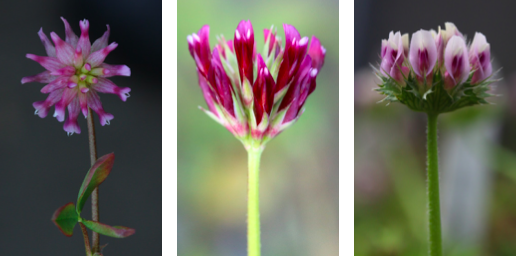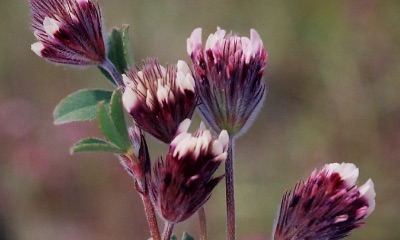Introduction

The genus Trifolium contains approximately 300 species and belongs in Fabaceae, the legume family. Peanuts, alfalfa, soybeans, and other important bean plants are also in Fabaceae. Many species in the family are host to nitrogen-fixing bacteria, making them useful in farming and gardening as a cover crop and for green composting. Some Trifolium species serve as food plants for butterflies and moths and some provide fodder for livestock. The name Trifolium translates to “three leaves” in Latin because the palmate leaves generally have three distinct leaflets (trifoliate). This attribute is certainly part of what makes the clovers so distinct, along with the flowering heads of small, often colorful flowers. Although these plants are typically small in stature, the vibrant colors and unique patterns of their inflorescences and leaves draw one’s eye and curiosity as they did Morgan.
As a genus brimming with intricacies, it is not a simple one to address. Those who have tried their hand at keying one of these clovers to species know sometimes it is no simple feat. One can end up completely stumped, and perhaps frustrated. Randall Morgan, the keen botanist he was, was aware of this and worked for years to uncover the complexities of this curious genus -- one which seems to abound in “ironies, contrasts, parallels, etc., both intrinsic and taxonomic” -- using morphological, biological, and genetic data. He was compelled to write a monograph, which he describes in the title as “a working inventory” -- an incomplete, in-progress piece rather than a definitive text -- focuses on the subsection Involucrarium. Annual and related perennial clovers native to western North America (one one species native to Chile) comprise this subsection of Trifolium. The paper was written with the hope to aid field botanists in identifying taxa in the group and to bring attention to unpublished taxa threatened by extinction.
Summaries of Randy's thinking, including keys, on the involucarium subsection of Trifolium are stored, password protected, here on the Randall Morgan Initiative Website. If you would like access to this content, send an email to both norris@ucsc.edu and cml@ucsc.edu expressing your interest.
Click here to access the password protected section on Trifolium subsect. involucarium

